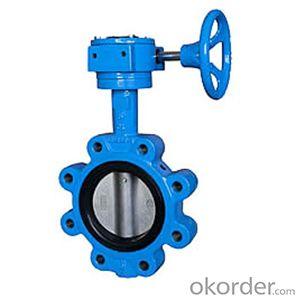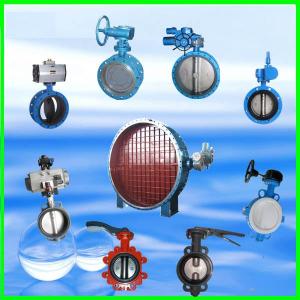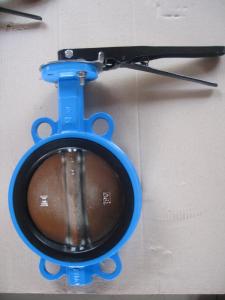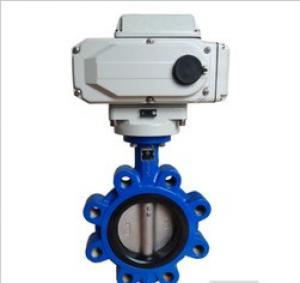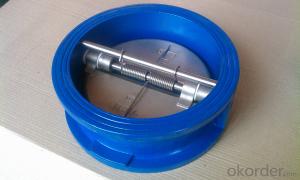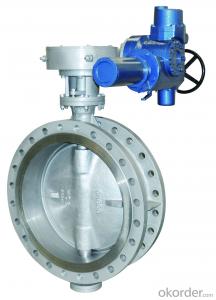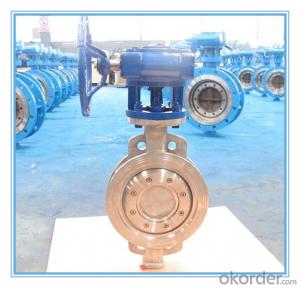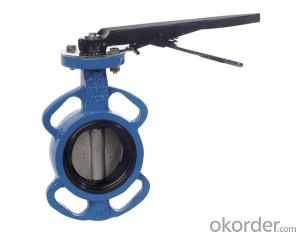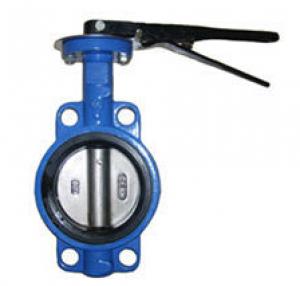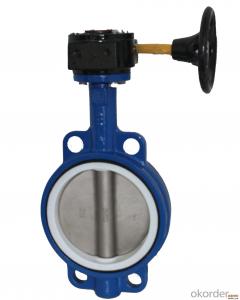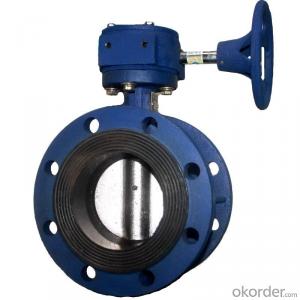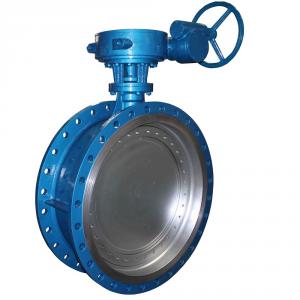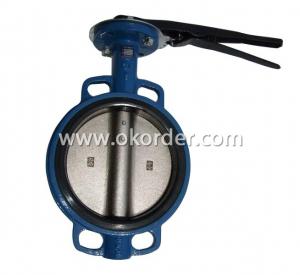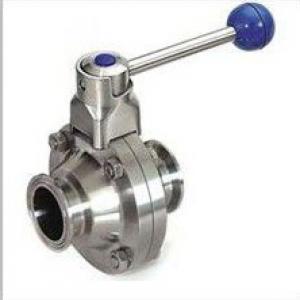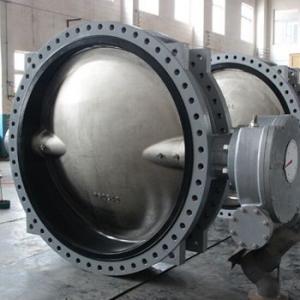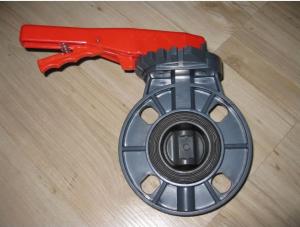Ductile Iron wafer butterfly valves DN100
- Loading Port:
- Tianjin
- Payment Terms:
- TT OR LC
- Min Order Qty:
- 100 set
- Supply Capability:
- 80000 set/month
OKorder Service Pledge
OKorder Financial Service
You Might Also Like
A butterfly valve consists of body ,stem ,disc , actuator (manual actuator, worm-gear actuator , aerodynamic actuator or electric actuator) , and wafer type butterfly valve can implement the process for turning on turning off and regulating the flow by the circumrotation of stem and disc that is droved by actuators.
1.Simple and compact construction. Small in size and light in weight. Easy transportation, installation and maintenance.
2. Quick 90 degrees on-off operation. Minimized operating torque ,energy saving.
3. Excellent sealing performance with no leakage. Long service life.
4. Wide selection of materials ,applicable for various media..
5. Flow curve tending to straight line. Excellent regulation performance.
- Q: does it come in when you go over a certain rpm or do the valves change depending on how far you depress the throtle?
- The variable is the valve timing. The spark plug fires a split second before the piston reaches the top of the stroke, to give the fuel a bit of time to burn. But, the faster the piston travels in the bore, that split second gets shorter shorter. So the engine computer changes when the spark plug fires when the valves close, to maximize the power from each ignition stroke.
- Q: I am confused as to the answer of this question. Please help.Indicate the status of the mitral, tricuspid and semilunar valves (whether they are open or closd) during the various phases of the cardiac cycle. Discuss the pressure in each of the relevant chambers or blood vessels during the phases with reference to the opening or closing of the valves.
- A heartbeat is a two-part pumping action that takes about a second. As blood collects in the upper chambers (the right and left atria), the heart's natural pacemaker (the SA node) sends out an electrical signal that causes the atria to contract. This contraction pushes blood through the tricuspid and mitral valves into the resting lower chambers (the right and left ventricles). This part of the two-part pumping phase (the longer of the two) is called diastole. The second part of the pumping phase begins when the ventricles are full of blood. The electrical signals from the SA node travel along a pathway of cells to the ventricles, causing them to contract. This is called systole. As the tricuspid and mitral valves shut tight to prevent a back flow of blood, the pulmonary and aortic valves are pushed open. While blood is pushed from the right ventricle into the lungs to pick up oxygen, oxygen-rich blood flows from the left ventricle to the heart and other parts of the body. After blood moves into the pulmonary artery and the aorta, the ventricles relax, and the pulmonary and aortic valves close. The lower pressure in the ventricles causes the tricuspid and mitral valves to open, and the cycle begins again. This series of contractions is repeated over and over again, increasing during times of exertion and decreasing while you are at rest. The heart normally beats about 60 to 80 times a minute when you are at rest, but this can vary. As you get older, your resting heart rate rises. Also, it is usually lower in people who are physically fit.
- Q: Butterfly valve common faults and treatment methods?
- Three, summary:Only familiar with every detail of circulating water pump outlet valve and butterfly valve equipment, timely and thorough maintenance and strict debugging, to ensure the safety and reliability of equipment operation, to ensure the healthy and orderly operation of equipment.
- Q: What's the difference between a butterfly valve and an eccentric butterfly valve? What is the difference in field applications?
- Eccentric butterfly valve and ordinary butterfly valve, when the butterfly valve is opened, the eccentric butterfly valve sealing surface will reduce great wear, in the opening, the disc will leave the valve at the first time the sealing surface!
- Q: How can one - way sealed butterfly valves and two-way sealed butterfly valves be distinguished?
- One way sealing butterfly valve is the front of the butterfly valve. When it closes, it must face the direction of the medium. The medium flows only in one direction, and the arrow on the valve body indicates the direction of the flow direction of the medium. Attention should be paid to the flow direction of the medium during installation. The two-way sealing butterfly valve is that the butterfly plate can face or back the direction of the medium, and the installation needs no attention to the direction of the flow of the medium, and the valve body also has no indication of the direction of the flow direction of the medium. Two way sealing butterfly valve stem force is greater than one-way butterfly valve stem. Design, the same diameter, pressure butterfly valve, two-way sealing butterfly valve stem diameter than one-way sealing butterfly valve stem diameter.
- Q: What does butterfly valve nps12cl150d373f4-150lb stand for?
- NPS (Nominal, Pipe, Size) abbreviation. Refers to the connection (including flanged and welding end) of the nominal diameter, followed by a digital unit is American Standard inches, 12 inches.NPS12 labeling system.CL is the abbreviation for class, and LB150 means the pressure is 150 poundsD stands for butterfly valves3 is expressed in the form of a turbine drive7 means of connection: to clip3 means sealing: 3 eccentricF4: the sealing material is PTFE
- Q: What's the difference between D71X-16 and D71H-16 butterfly valves?
- First, model D71X model means that, on behalf of 7 representative D butterfly valve, butterfly valve connection form for clamp connections, 1 straight, X represents the seal in the form of soft sealing, the sealing surface usually NBR H metal seal is usually 2Cr13 16 represents the pressure of 16 kg pressure weldingJin Ya valve is the production of hard sealing butterfly valve or soft sealing butterfly valve line leader, what problems can ask their units, technicians will answer for you
- Q: How does the pneumatic butterfly valve control the angle of opening?
- This is really not good, control seems to be pneumatic defects, can only rely on the feeling
- Q: How does PLC control butterfly valves?
- PLC control butterfly valve, usually control pneumatic butterfly valve or electric butterfly valve, see which way you control butterfly valve.PLC control pneumatic butterfly valve, that is, PLC program control, electric control, gas control, gas control butterfly valve;PLC control electric butterfly valve, that is, PLC program control electric, electric control butterfly valve.Ordinary switch butterfly valve is the program control on and off, to the 1 way valve open, to another 1 way valve off.
- Q: i was changing valve seals and two dropped i can see the head of the valve but a magnet wont pull them up i put air the spark plug hole too but no luck 1985 ford bronco II
- Your going to have to pull the heads.
Send your message to us
Ductile Iron wafer butterfly valves DN100
- Loading Port:
- Tianjin
- Payment Terms:
- TT OR LC
- Min Order Qty:
- 100 set
- Supply Capability:
- 80000 set/month
OKorder Service Pledge
OKorder Financial Service
Similar products
Hot products
Hot Searches
Related keywords
